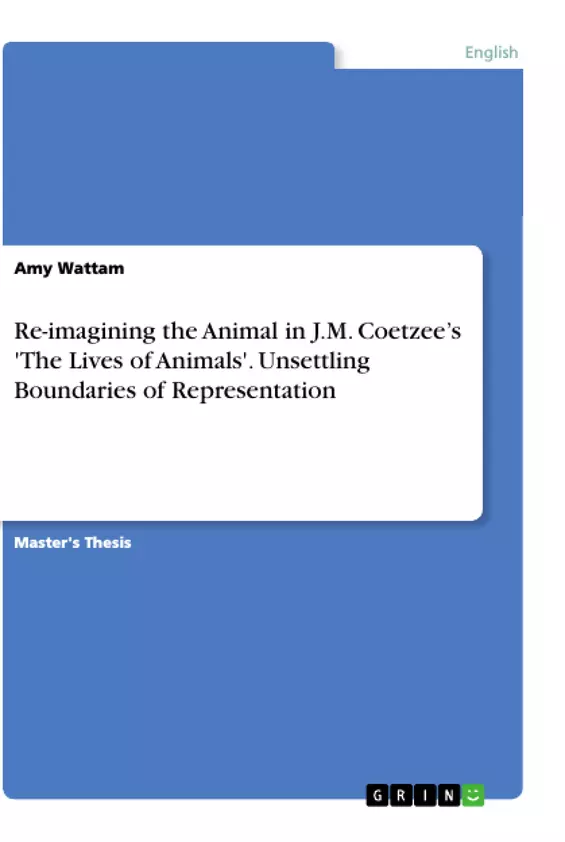This paper re-imagines the animal in J.M. Coetzee’s "The Lives of Animals”. It focuses on how Coetzee’s narrative problematizes dominant discourses through questioning their authority. Furthermore, the narrative offers alternatives to anthropocentric conceptions of the animal that are based upon reason-centred and dualistic thought. The duality of human versus animal is explored alongside other dualities deconstructed in the text, such as fiction versus non-fiction, and philosophy versus literature.
Coetzee’s representation of these constructs and their interconnectedness is investigated, specifically with regard to positively developing human-animal relations. Through exploring what Coetzee calls the 'sympathetic imagination', his alternative contribution to the field of human-animal relations will be considered. This study focuses on the space for re-imagination that Coetzee has provided with "The Lives of Animals".
It highlights the role literature can and ought to play in this re-imagination, and why this re-imagination is necessary for the development of human-animal relations. Posthumanism will be used as a theoretical lens throughout, as it appears to resonate closely with Coetzee’s project. Both the form and the content of the text will be analysed, highlighting their interconnected significance in Coetzee’s project and the continued relevance of interventions such as this.
J.M. Coetzee’s "The Lives of Animals" (1999) is a literary representation of, and intervention into, human-animal relations. It is an experimental literary destabilization of the generic boundaries that underlie the systematic (mis)representation and (mis)treatment of nonhuman animals, specifically their mass commodification in contemporary societies. The text provides a critique and negotiation of anthropocentric reason and its ramifications for nonhuman animals.
Inhaltsverzeichnis (Table of Contents)
- Introduction
- Chapter One: Studying The Lives of Animals - Situation, Reception and Theory
- 1.1. Introduction
- 1.2. Situating The Lives of Animals
- 1.3. Critical Reception
- 1.4. A Posthumanist Reading
- 1.5. Conclusion
- Chapter Two: Coetzee and Unsettling Boundaries of (Re)presentation
- 2.1. Introduction
- 2.2. Coetzee's Multimodal Metafiction
- 2.3. Coetzee's Relation to The Lives of Animals
- 2.4. Coetzee's Multi-layered Responses
- 2.5. Conclusion
- Chapter Three: Disconnections in The Lives of Animals
- 3.1. Introduction
- 3.2. Human versus Animal
- 3.3. Reason versus Feeling
- 3.4. Rationality versus Imagination
- 3.5. Conclusion
- Chapter Four: Establishing Connections in The Lives of Animals
- 4.1. Introduction
- 4.2. Elizabeth and the Animal
- 4.3. Rational Feelings and Human-Animal Interconnection
- 4.4. Imaginative Realities and Human-Animal Relations
- 4.5. Conclusion
Zielsetzung und Themenschwerpunkte (Objectives and Key Themes)
This study aims to explore the complex relationship between humans and animals through an analysis of J.M. Coetzee's The Lives of Animals. It delves into how Coetzee's work challenges conventional boundaries of representation and re-imagines the animal through multifaceted forms and content. The study also examines the significance of literature in re-imagining human-animal relations and how the text can be used as a tool for positive change.
- Coetzee's critique of anthropocentric reason and its impact on nonhuman animals.
- The destabilization of generic boundaries and the blurring of lines between fiction and non-fiction, philosophy and literature.
- The exploration of dualities such as human versus animal, reason versus feeling, and rationality versus imagination.
- The role of the "sympathetic imagination" in re-imagining human-animal relations.
- The potential of literature to contribute to the re-imagination of human-animal relations.
Zusammenfassung der Kapitel (Chapter Summaries)
Chapter One examines the context and reception of Coetzee's The Lives of Animals, establishing the significance of the text within the discourse on human-animal relations. It introduces the concept of posthumanism as a potential theoretical lens for understanding the work.
Chapter Two analyzes Coetzee's unique use of multimodal metafiction and explores how he challenges conventional boundaries of representation through his unconventional approach to portraying the animal. The chapter delves into Coetzee's own relation to the text and its multi-layered responses.
Chapter Three examines the disconnections presented in the text, specifically exploring the human-animal dichotomy and the opposition between reason and feeling, rationality and imagination.
Chapter Four focuses on the connections established in The Lives of Animals. It examines the relationship between Elizabeth and the animal, exploring how rational feelings and imaginative realities contribute to human-animal interconnection.
Schlüsselwörter (Keywords)
The Lives of Animals, J.M. Coetzee, human-animal relations, anthropocentrism, posthumanism, sympathetic imagination, metafiction, representation, re-imagination, animal rights, animal welfare, ethics.
- Arbeit zitieren
- Amy Wattam (Autor:in), 2019, Re-imagining the Animal in J.M. Coetzee’s 'The Lives of Animals'. Unsettling Boundaries of Representation, München, GRIN Verlag, https://www.grin.com/document/987377



